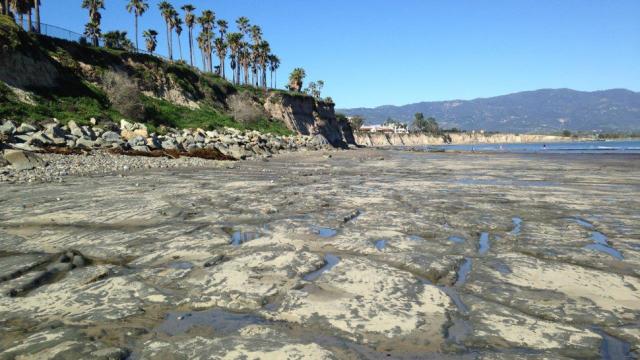Using a new computer model, scientists predict that upwards of 67 per cent of Southern California beaches could be severely damaged by rising sea levels in the next 80 years.
Exposed bedrock on the beach near the University of California, Santa Barbara, in February 2017. (Image: Daniel Hoover, USGS)
A new study published in the Journal of Geophysical Research warns that 31 to 67 per cent of Southern Californian beaches are at risk of complete erosion by the year 2100 under predicted scenarios of sea-level rise of 1-2m. In addition to devastating the local tourist economy, the lost beaches will eliminate an important defence for the 18 million people who live near the coast. The lead author of the study, Sean Vitousek from the US Geological Survey and the University of Illinois at Chicago, says massive and costly interventions will be required to preserve the 500km of coastline that’s poised to be affected.
“Beaches are perhaps the most iconic feature of California, and the potential for losing this identity is real,” noted Vitousek in a release. “The effect of California losing its beaches is not just a matter of affecting the tourism economy. Losing the protecting swath of beach sand between us and the pounding surf exposes critical infrastructure, businesses and homes to damage. Beaches are natural resources, and it is likely that human management efforts must increase in order to preserve them.”
For the study, Vitousek and his colleagues used a computer modelling system called CoSMoS-COAST, which stands for “Coastal Storm Modelling System — Coastal One-line Assimilated Simulation Tool”. This tool is specifically designed to predict how shorelines will respond to the effects of climate change in the 21st century. The model can accommodate virtually any coastal setting, including complex features such as dunes, bluffs, cliffs, estuaries, river mouths and even urban infrastructure.
The researchers used CoSMoS-COAST to look at sand transport along and across 500km of coastline, factoring in such variables as waves and the expected sea-level rise. The system also used historical shoreline positions to get a sense of how beaches change in response to waves, storms and weather cycles such as El Niño. Los Angeles’ beaches were hit particularly hard by El Niño, including Cabrillo Beach which now features a predominantly rocky shoreline.
Protecting the beaches from the expected levels of erosion will be time-consuming and costly. Possible counter measures include the construction of jetties, breakwaters and wall-like structures called groins. Even the act of dumping boulders onto shorelines can help, though they’re unsightly and they kill the beach-going vibe. Recently, residents of Malibu’s Broad Beach spent $US31 million ($40.5 million) to add 2000 truckloads of sand to their coastline, but the sand is only expected to last about a decade. Durable textiles and control mats can also be used on the beach itself to foster the growth of erosion-fighting vegetation. Santa Monica is currently restoring its beach with native plant landscaping for this very purpose.
It’s a very sad state of affairs, and a shame that local residents are having to take such drastic measures. Sadder still that the US federal government is turning a blind eye to the seemingly never-ending effects of climate change.
